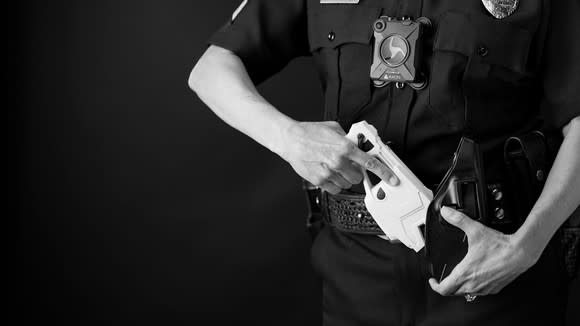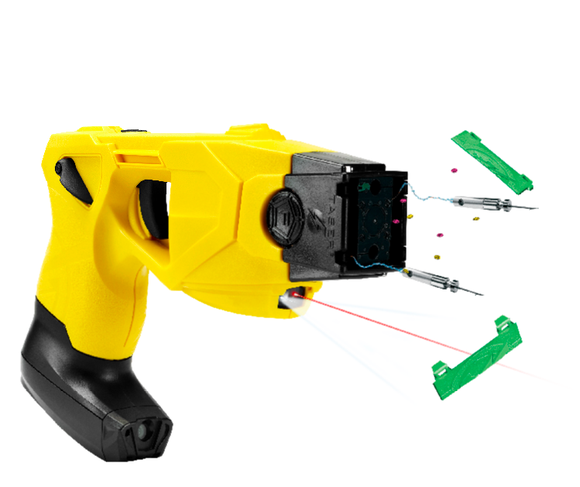Are Axon Enterprise's Tasers Inherently Dangerous?
A U.N. watchdog is suggesting that the use of Tasers by some jail guards amounts to torture and is calling for authorities to investigate the cases and consider filing criminal charges.
A running series by the news agency Reuters on the use of the stun gun in prisons found that since 2000, over 100 inmates died after the devices were used on them. After viewing videos of some of the incidents, Nils Melzer, the U.N.'s special rapporteur on torture, called their usage "clearly gratuitous" and said the cases warranted investigation and probable prosecution. What does this mean for their manufacturer, Axon Enterprises (NASDAQ: AAXN)?

Image source: Axon Enterprise.
A clear and present danger?
Reuters says that of the 104 prisoners who died, only two were armed when the Tasers -- which Axon calls "conducted electrical weapons" (CEWs) -- were deployed, and a third of the people were already restrained in some fashion, such as by handcuffs.
The U.N. official said those cases "require independent investigation and most of them are likely to merit prosecution" because they may have violated the U.N.'s prohibition on cruel, unusual, or degrading punishment.
The full Reuters study of over 1,000 cases heavily suggests that the Taser is an inherently dangerous weapon. While it notes that most independent researchers who've studied the weapons say deaths are rare when Tasers are used properly, and Axon itself says that only 24 people have ever been killed directly as a result of a CEW being deployed, Reuters also suggests that the real number is incalculable because of a lack of data on stun gun use and other factors that may contribute to a death.
Axon Enterprises notes that over the past two-and-a-half decades, Tasers have been used by police more than 3.5 million times and that the device is the "most studied less lethal tool on an officer's belt." It also points out that a 2009 Department of Justice-funded study has found that Tasers were used without significant injury to the suspect in 99.75% of 1,201 deployments.
A powerful weapon
The Taser is designed to be a less-than-lethal weapon. When triggered, two darts connected by thin wires are fired from the device, powered by 50,000 volts of electricity.

Image source: Axon Enterprise.
However, it's not so much the voltage that matters, but rather the delivered charge, which is measured in microcoulombs. Reuters reports that the original Taser delivered 70 microcoulombs per pulse of electricity, but because it wasn't enough to stop determined assailants, the company bumped it up to 85 microcoulombs, and its best-selling X26 Taser delivered 100 microcoulombs per pulse with as much as 135 microcoulombs delivered upon first impact.
However, with the development of the X3 model and the subsequent X2, Axon lowered the delivered charge to just 63 microcoulombs. A Houston police officer has filed a lawsuit against Axon after she was seriously injured following deployment of the X2, which failed to stop her assailant. Her lawsuit claims that Axon lowered the amount of microcoulombs because of the negative publicity surrounding some of the deaths, but failed to notify police departments it had done so.
A profitable defensive tool
Axon certainly has a vested interest in seeing that the devices are properly and safely used. Although it has made a move into body cameras and evidence database management -- areas that carry the potential for significant growth for the company -- the Taser remains its largest contributor to revenue. Over the first nine months of 2017, Taser sales totaled $170.1 million, or 68% of the $249.1 million total Axon generated. They also represent 80% of its gross profit margin and all of its operating margin.
There's little argument that some uses of a Taser may cross the line to abuse, and such instances should be investigated and prosecuted. Yet in general, the deployment of conducted electrical weapons may have created a much safer environment for both the suspect and the officer, as it allows the officer to maintain a safe distance from a suspect while being able to control someone without resorting to lethal force.
As the Reuters series notes, more often than not there are a combination of factors that contribute to the death of someone following the use of a Taser, such as the ingestion of drugs. There also seems to be a tendency toward greater use on persons who are mentally ill. Yet the data presented seem to show that abuse is actually quite rare. So rather than being inherently unsafe, in most cases Tasers more likely help to prevent more lethal methods of control from being deployed. Which means that Axon's most profitable product seems at no risk of going away anytime soon.
More From The Motley Fool
Rich Duprey has no position in any of the stocks mentioned. The Motley Fool owns shares of and recommends Axon Enterprise. The Motley Fool has a disclosure policy.
